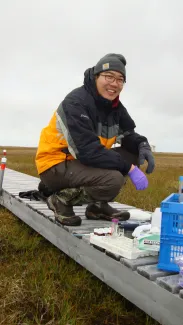Understanding Effects of Warming on Tundra Soil Organic Carbon Degradation Pathways
Frozen Arctic soils represent one of the largest pools of stored soil organic carbon, but it is unclear which types of SOC are easy to decompose after the soil thaws and what are the degradation mechanisms. Using a suite of chromatographic and spectroscopic techniques, Ziming Yang and co-workers at Oak Ridge National Laboratory examined the dynamic consumption and production of labile SOC in a tundra soil from the Barrow Environmental Observatory, Barrow, Alaska, United States. They found that degradation of simple sugars and alcohol in thawed SOC largely accounts for the initial rapid release of CO2 and CH4 by microorganisms in the absence of oxygen. Organic acid fermentation products accumulated over time, fueling later production of CH4 and CO2. A conceptual framework for labile SOC transformations and their relations to fermentation, iron reduction, and methanogenesis is proposed for improved model prediction of climate feedbacks in the Arctic.
Climate warming and permafrost thaw enhances degradation of frozen soil organic carbon (SOC) and, in turn, the emission of methane (CH4) and carbon dioxide (CO2) from Arctic landscapes. Yet, which fractions of SOC are most vulnerable to rapid breakdown and what mechanisms control the SOC degradation remain unclear. Molecular-scale characterization of SOC precursors and degradation products will allow researchers to better predict the seasonal and climatic controls on CH4 and CO2 emissions in the Arctic.
In a new publication by Ziming Yang and others, insights are provided into the rates and pathways of SOC transformations in Arctic tundra upon warming. The results could be integrated into mechanistic Earth System Models to better predict the dynamics of SOC formation and degradation in Arctic ecosystems.
Yang, Z, SD Wullschleger, L Liang, DE Graham, and B Gu. 2016. Effects of warming on the degradation and production of low-molecular-weight labile organic carbon in an Arctic tundra soil. Soil Biology and Biochemistry. Soil Biology and Biochemistry, 95:202-211. https://doi.org/10.1016/j.soilbio.2015.12.022
This research was supported by the Director, Office of Science, Office of Biological and Environmental Research of the US Department of Energy under Contract No. DE-AC02-05CH11231 as part of the Next-Generation Ecosystem Experiments (NGEE Arctic) project.
For more information, please contact:
Baohua Gu
gub1@ornl.gov

